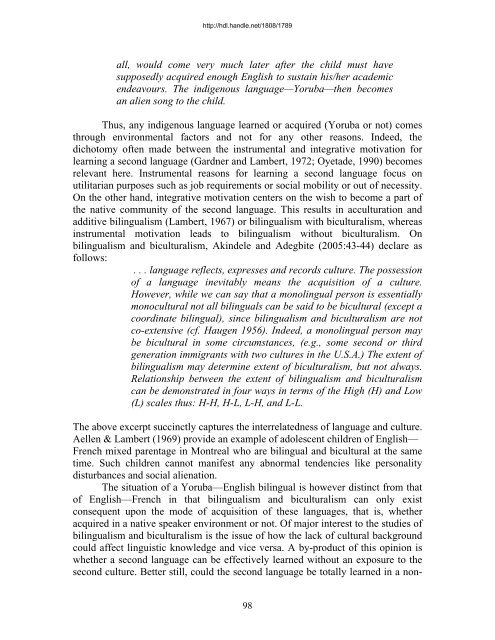LANGUAGE CONTACT AND LANGUAGE ... - KU ScholarWorks
LANGUAGE CONTACT AND LANGUAGE ... - KU ScholarWorks
LANGUAGE CONTACT AND LANGUAGE ... - KU ScholarWorks
You also want an ePaper? Increase the reach of your titles
YUMPU automatically turns print PDFs into web optimized ePapers that Google loves.
http://hdl.handle.net/1808/1789<br />
all, would come very much later after the child must have<br />
supposedly acquired enough English to sustain his/her academic<br />
endeavours. The indigenous language—Yoruba—then becomes<br />
an alien song to the child.<br />
Thus, any indigenous language learned or acquired (Yoruba or not) comes<br />
through environmental factors and not for any other reasons. Indeed, the<br />
dichotomy often made between the instrumental and integrative motivation for<br />
learning a second language (Gardner and Lambert, 1972; Oyetade, 1990) becomes<br />
relevant here. Instrumental reasons for learning a second language focus on<br />
utilitarian purposes such as job requirements or social mobility or out of necessity.<br />
On the other hand, integrative motivation centers on the wish to become a part of<br />
the native community of the second language. This results in acculturation and<br />
additive bilingualism (Lambert, 1967) or bilingualism with biculturalism, whereas<br />
instrumental motivation leads to bilingualism without biculturalism. On<br />
bilingualism and biculturalism, Akindele and Adegbite (2005:43-44) declare as<br />
follows:<br />
. . . language reflects, expresses and records culture. The possession<br />
of a language inevitably means the acquisition of a culture.<br />
However, while we can say that a monolingual person is essentially<br />
monocultural not all bilinguals can be said to be bicultural (except a<br />
coordinate bilingual), since bilingualism and biculturalism are not<br />
co-extensive (cf. Haugen 1956). Indeed, a monolingual person may<br />
be bicultural in some circumstances, (e.g., some second or third<br />
generation immigrants with two cultures in the U.S.A.) The extent of<br />
bilingualism may determine extent of biculturalism, but not always.<br />
Relationship between the extent of bilingualism and biculturalism<br />
can be demonstrated in four ways in terms of the High (H) and Low<br />
(L) scales thus: H-H, H-L, L-H, and L-L.<br />
The above excerpt succinctly captures the interrelatedness of language and culture.<br />
Aellen & Lambert (1969) provide an example of adolescent children of English—<br />
French mixed parentage in Montreal who are bilingual and bicultural at the same<br />
time. Such children cannot manifest any abnormal tendencies like personality<br />
disturbances and social alienation.<br />
The situation of a Yoruba—English bilingual is however distinct from that<br />
of English—French in that bilingualism and biculturalism can only exist<br />
consequent upon the mode of acquisition of these languages, that is, whether<br />
acquired in a native speaker environment or not. Of major interest to the studies of<br />
bilingualism and biculturalism is the issue of how the lack of cultural background<br />
could affect linguistic knowledge and vice versa. A by-product of this opinion is<br />
whether a second language can be effectively learned without an exposure to the<br />
second culture. Better still, could the second language be totally learned in a non-<br />
98
















